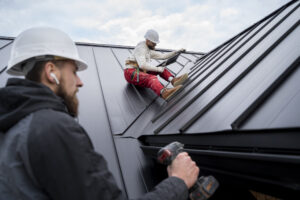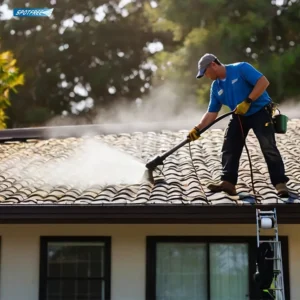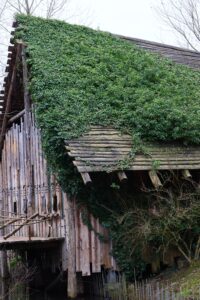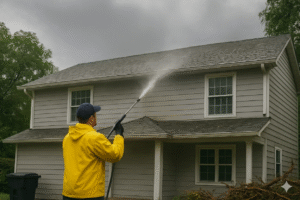Rust is more than just an unsightly condition in Florida’s humid coastal climate; it poses a structural risk. Oxidation silently eats away at surfaces, weakening metals and discoloring concrete on everything from driveways and high-rise parking decks to residential fences.
However, there is no one-size-fits-all strategy for preventing corrosion. While residential applications place more emphasis on long-term maintenance and aesthetics, Commercial Rust Treatment Services demand industrial-grade protection plans.
The science behind corrosion, how rust treatment varies by type of property, and how expert rust removal services maintain structural integrity and value are all covered in this extensive guide.
Understanding Rust: The Science Behind Corrosion
Iron oxide, a flaky substance that erodes structural materials, is produced when iron or steel combines with oxygen and moisture to form rust.
In Florida and the Gulf Coast, where humidity levels are higher than 70% and airborne salt functions as an electrolyte to speed up oxidation, the reaction speeds up.
Important Causes of Rust Formation
- High humidity, irrigation, and rain are examples of moisture exposure.
- Salt and Chemicals: Metal corrodes more quickly in the presence of sea air and cleaning solutions.
- Temperature Variations: Cracks for moisture intrusion are created by expansion and contraction.
- Neglected Coatings: The metal becomes visible when paint or sealants deteriorate.
Although rust may seem like a minor discoloration, the structural harm it causes can make repairs three to five times more expensive than if it were treated early.
Commercial vs Residential Environments: Different Challenges
Factories, fleets, parking garages, and warehouses are examples of commercial settings that are continuously exposed to pollutants, machinery runoff, and high foot traffic.
Typical sources of rust include:
- Cooling towers and HVAC condensers
- Metal facades, handrails, and structural beams
- Delivery zones and loading docks for ships
- Chemical overspray in industrial wash bays
Commercial Rust Treatment Services here concentrate on:
- Prevention of corrosion on a large scale
- Integrity of the surface for public safety
- Adherence to EPA and OSHA regulations\
Household Real Estate
Rust usually shows up in homes in:
- Walkways and driveways (from sprinkler systems)
- Railings and patio furniture
- Fences and garage doors
- AC units and roof fasteners
Rust removal services in residential settings are more aesthetically pleasing, maintaining curb appeal while safeguarding the value of the home.
In contrast to deep industrial coatings, the treatments are typically lighter and concentrate on surface restoration.
The Scale of Damage: Industrial vs Home Rust Exposure
Impact on the Business World
According to a 2024 corrosion study conducted by the National Association of Corrosion Engineers (NACE), corrosion-related damage costs American industries close to $280 billion a year.
Unchecked rust in industries like construction, property management, and logistics can:
- Reduce the lifespan of metal assets and equipment by as much as 40%.
- Raise upkeep expenses by 25–30% per year.
- Result in insurance fines or structural safety infractions.
Methods Used in Commercial Rust Treatment Services
Multi-phase, high-performance methods intended for compliance and durability are used in professional rust treatment for commercial properties.
Step 1: Preparing the Surface
- To get rid of oxidation and dirt, use soft washing or high-pressure washing.
- Neutralizers made of industrial-grade chemicals to get rid of rust residue.
- For severe corrosion on steel tanks or beams, abrasive blasting is used.
Step 2: Conversion to Rust
- Application of rust converters based on phosphoric acid, which chemically transform rust into stable substances.
- Primes the surface for coating and stops additional oxidation.
Step 3: Protection & Coating
- For long-term protection, polyurethane sealants and epoxy primers are applied.
- Zinc-rich coatings are applied for cathodic protection in industrial or marine environments.
Step 4: Programs for Maintenance
- Planned examinations every six to twelve months.
- Re-sealing the surface and keeping an eye on corrosion are preventative measures.
This methodical approach guarantees regulatory compliance, increased asset lifespan, and aesthetic improvement.
Methods Used in Residential Rust Treatment
While still being effective, rust treatment for buildings take a kinder approach.
Step 1: Cleaning the Surface
- Utilizing acid-neutral cleaners that are safe for metal, stucco, and concrete surfaces.
- Washing with low pressure to avoid damaging surfaces.
Step 2: Specific Rust Elimination
- Solutions of citric or oxalic acid that are applied by hand or with sprayers.
- For precise work on doors or railings, specialized brushes are utilized.
Step 3: Protective Coating
- Application of rust inhibitors or clear sealants.
- Protective paints or waxes for outdoor railings and furniture.
Step 4: Continued Assistance
- Modifications to sprinkler systems to avoid mineral stains.
- Metal surfaces exposed to moisture should be re-coated once a year.
The process’s objective is easy homeowner maintenance and long-lasting aesthetics, despite its smaller scope.
Key Differences Between Commercial and Residential Rust Treatment
Feature | Commercial Properties | Residential Properties |
Surface Type | Structural steel, fleets, equipment, parking decks | Fences, furniture, driveways, garage doors |
Primary Goal | Structural preservation and compliance | Curb appeal and surface protection |
Chemicals Used | Industrial rust converters and epoxy coatings | Mild, eco-friendly rust removers |
| Maintenance Frequency | Every 6 months | 1–2 times a year |
Team Expertise | Licensed industrial technicians | General rust treatment specialists |
Compliance Standards | OSHA, EPA, industrial safety codes | Home improvement safety guidelines |
This contrast demonstrates how residential rust control strikes a balance between aesthetics and ease of maintenance, while commercial rust treatment services are designed for scale and durability.
Preventive Rust Strategies: Long-Term Solutions
Commercial Real Estate
- Frequent Inspections: For exposed steel structures, every three to six months.
- Waterproof Barriers: Stop salt and moisture intrusion.
- Protective Coatings: Surface life is increased by ceramic, polyurethane, and zinc coatings.
- Electrochemical Protection: Sacrificial anodes for big steel structures provide electrochemical protection.
Household Real Estate
- Surface Painting: Premium outdoor paints that contain rust inhibitors.
- Control drainage by preventing water from collecting close to metal objects.
- Gently Cleaning: Get rid of rust stains before they get worse.
- Localized Repairs: To stop the spread of rust, take quick care of small areas.
By extending the lifespan of metal surfaces by 15 to 20 years, preventive maintenance can save thousands of dollars on replacement expenses.
Why Professional Rust Removal Services Are Worth It
Although do-it-yourself rust removal kits can remove minor surface stains, they hardly ever address underlying issues like micro-pitting or electrolytic corrosion.
Expert rust removal services offer:
- Advanced Diagnostics: Determine the root causes of oxidation.
- Compared to retail products, industrial-grade solutions offer longer-lasting protection.
- Eco-Safe Methods: Chemical handling that respects the environment.
- Guaranteed protection and scheduled inspections are provided by the warranty and aftercare.
Professional supervision of commercial facilities also guarantees adherence to safety and environmental standards, which is crucial in sectors like property management, hospitality, and logistics.
The Economics of Rust Prevention
According to the U.S. Federal Highway Administration, corrosion affects buildings, cars, and infrastructure and costs the country close to 3.1% of GDP each year.
Rust treatment for buildings provides a substantial return on investment for preventive maintenance:
- Six to ten dollars can be saved on future repairs for every dollar spent on rust prevention.
- Over a ten-year period, buildings that implement systematic corrosion management programs see maintenance costs drop by 30 to 50%.
- The lifespan of steel and concrete can be increased by more than 20 years with routine coating renewal.
The lesson is always the same whether running a commercial building or a residential community: proactive maintenance is always less expensive than reactive repair.
Squeaky Clean Services: Florida’s Rust Treatment Experts
Nobody knows Florida’s climate-driven corrosion problems better than Squeaky Clean Services.
Our commercial rust treatment services restore metal structures, get rid of stubborn stains, and stop further damage by combining eco-friendly protection with industrial precision.
Our skilled technicians employ cutting-edge rust removal, neutralization, and prevention methods specific to your property type, whether they are working on residential driveways or expansive parking structures.
We preserve in addition to cleaning. Our dedication to longevity, safety, and adherence to environmental regulations supports each treatment.
Squeaky Clean Services guarantees that your surfaces will remain sturdy, pristine, and protected for many years to come when it comes to shielding your property from the corrosive Florida climate.







